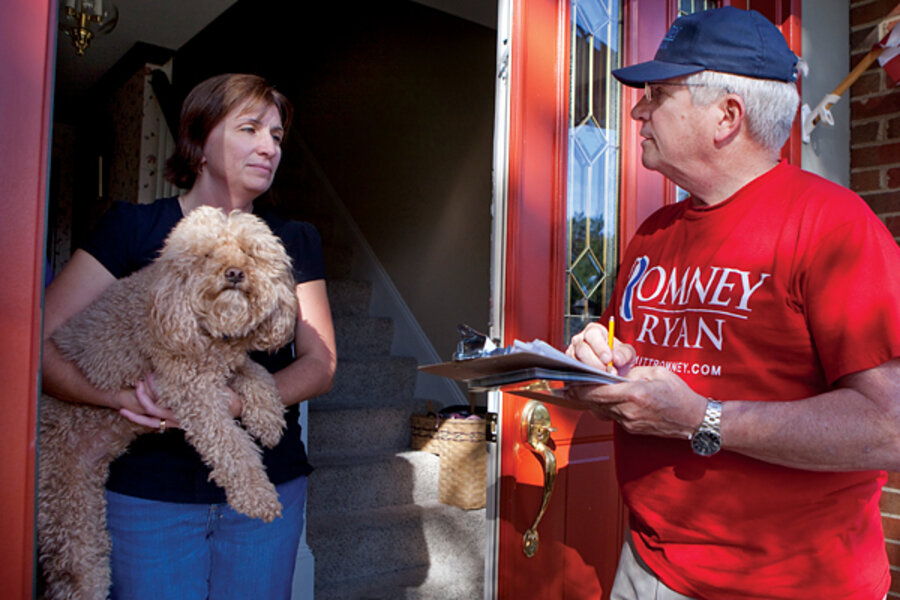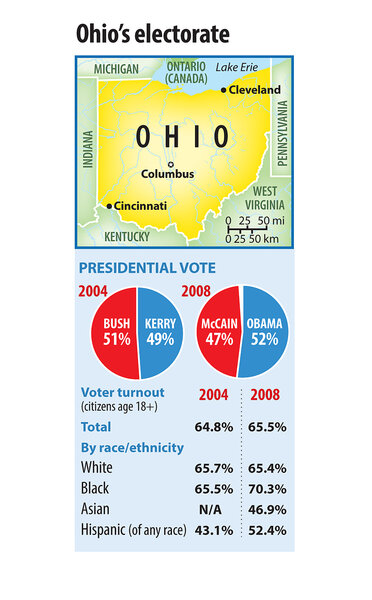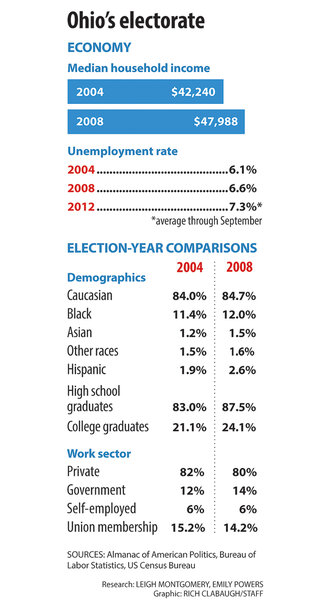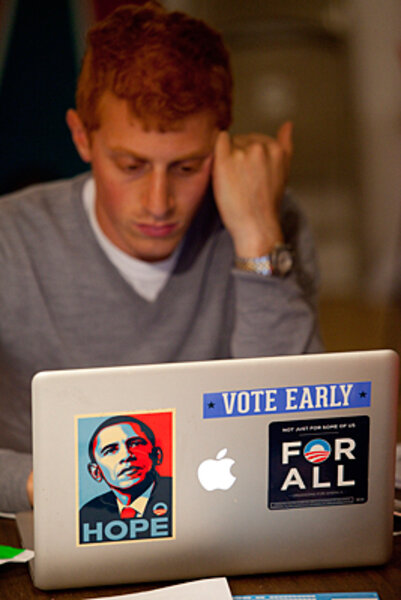Crunch time in Ohio, as Obama, Romney blitz to get out the vote
Loading...
| Upper Arlington, Ohio
(Story updated Wednesday, 8:30 a.m. EDT.)
Jeff Johnson strides up the front walk of a tidy home in suburban Columbus, Ohio, and knocks, ready with three questions: Will you support the Romney-Ryan ticket? If yes, would you like a yard sign? And have you voted yet?
The scene plays out over and over on a recent Tuesday afternoon – before hurricane Sandy dusted the region with snow – and to Mr. Johnson's surprise, plenty of folks answer the door: retirees, moms with kids, people who work from home. Most support Mitt Romney for president. After all, it's a predominantly Republican neighborhood. Only a few won't talk. One supports President Obama. And it's all valuable data, which Johnson records for the Romney campaign on his daily rounds as one of the top Republican door-knockers in Ohio.
It's crunchtime in Election 2012, and particularly in the battleground states, the campaigns are all about Getting Out the Vote – GOTV. Nowhere is voter outreach more important than in Ohio, the state that could well decide the presidential race.
TV and radio ads, phone calls, direct mail, social media, candidate appearances that create buzz – those all matter. But in the age of media saturation, nothing works like old-fashioned, in-person contact in motivating people to cast ballots, strategists say. And after getting beat by Mr. Obama organizationally four years ago, the Republicans have stepped up their ground game – in Ohio and in other swing states.
"You can call it 'back to the future': the return to door knocking," says Scott Jennings, director of the Romney campaign in Ohio. "It's the personal interaction that matters, and it's the targeting that matters."
The key, for both campaigns, is first to figure out who their supporters are, house by house; assess the strength of that support; and then determine the likelihood that those people will actually vote.
Ohio has made it easy to vote early. On Aug. 31, the state mailed an absentee-ballot request form to every voter. On Oct. 2, in-person early voting started. By Oct. 23, more than 800,000 Ohioans had already voted by one or the other method. With data from the county Boards of Elections, the campaigns can track, on a daily basis, who has voted or requested an absentee ballot.
For those who might be lukewarm about voting, the in-person touch is especially crucial. And it is these so-called low-propensity voters who can determine the outcome in Ohio, where Obama has a slight edge, and maybe in the election – which is a dead heat. Mr. Jennings says he can see a direct correlation between his door-to-door programming and then the number of Republicans who are "low- to mid-propensity voters" requesting ballots and voting early.
With just days to go before Election Day, the race is too close to call – and suggests the possibility of a popular vote victory for Romney and an Electoral College victory for Obama. On Wednesday, the RealClearPolitics average of polls shows Romney ahead nationally by 0.8 percentage points. In Ohio, Obama leads by an average 2.4 percentage points in public polls.
As of Tuesday, the Romney campaign has knocked on 2.2 million doors and made 4.7 million phone calls in Ohio, the campaign reports.
The Obama campaign declines to provide specifics on door knocks and phone calls in Ohio. But maybe these numbers don't really matter, because effective GOTV is all about targeting the right people, not just the quantity of those contacted. And the numbers of "door knocks" include people who don't answer the door.
There's one number that Obama for America is happy to tout: its 130 field offices around the state, more than any other state campaign operation in the country. That's more than three times the 40 joint Romney-Republican National Committee "victory centers" around Ohio.
"We want to make it easy for anyone who wants to participate," says Aaron Pickrell, senior adviser to the Obama campaign in Ohio. The more offices you have, he says, the smaller the geographic area each one covers, making it easier for canvassers to bring a local touch to their conversations with voters.
"That's why we focus so heavily on neighbor-to-neighbor and door knocks," Mr. Pickrell says. "Talking to your neighbor is a way to break through."
Four years ago, Obama beat John McCain in the early vote with his superior ground game, as 30 percent of voters nationally cast their ballots early. This year, as many as 40 percent are expected to vote early. In Ohio, polls show Obama winning the early vote by a substantial margin, but Romney is winning among those who plan to vote on Election Day.
So even as the Republicans under Romney have ramped up their ground game, Obama and the Democrats, too, have stepped on the gas. They've had a significant head start, since Obama faced no primary challenger. His campaign could work on ground organization for the general election while Romney was still fighting for the GOP nomination, which he didn't clinch until May. In Ohio, an internecine battle within the state Republican leadership earlier this year also hindered organization, Republicans say privately.
The Obama campaign is confident it has a superior ground game nationally.
"We have been planning for this race and for these next two weeks for two years," said senior Obama adviser David Axelrod after the Oct. 22 presidential debate.
The Obama campaign also appears off to a big head start in Ohio in early voting. A Rasmussen poll taken Oct. 28 reports that among people who say they have already voted, Obama is beating Romney 62 percent to 36 percent. But the poll also shows Romney with a large lead among those who still plan to vote.
Early voting in Ohio became a highly charged issue when the Republican-led legislature ended it for the final weekend before the election, except for members of the military and overseas residents. Critics said the law could disenfranchise minority voters, such as those who take part in early-vote programs run by African-American churches called "take your souls to the polls" on the last Sunday before the election. The Obama campaign successfully sued, on grounds of equal protection.
But the racial dimension of voting in Ohio hasn't ended. Billboards posted in predominantly black and Hispanic neighborhoods in Cleveland, Cincinnati, and Columbus (as well as Milwaukee) featured this message: "Voter fraud is a felony! Up to 3 1/2 yrs & $10,000 fine." Local politicians and civil rights activists called the signs racist and intimidating.
Clear Channel Outdoor – the company that sold the ad space to an out-of-state family foundation that was granted anonymity – agreed to donate the use of 10 billboards with a different message: "Voting is a right. Not a crime!" A civil rights group based in Washington, D.C., is paying for additional billboards with a similar message, the Cleveland Plain Dealer reports.
On Oct. 21, Clear Channel announced it was taking down the "felony" billboards in Cleveland.
Early voting in Columbus: Passions run high
Inside the early-voting center in Columbus, located in a former Kohl's department store, one would hardly know that early voting had become such a fraught issue in Ohio. Two contractors, a Republican and a Democrat, keep watch over the facility that includes 100 electronic voting machines, making sure that correct procedures are followed.
But outside, beyond the yellow line that delineates where leafleting is allowed, passions run high. When Democratic volunteer Phyllis Elmo gives her name, she adds without being asked: "Yes, I want to save 'Sesame Street'!"
The frustration really pours out when Ms. Elmo, who is Roman Catholic, says she recently walked out of church for the first time in her life over the priest's sermon criticizing Obama on abortion.
"I'm pro-life, but it's not the most important issue," says Elmo, a retired state employee. "What about health care, services to people in poverty, and other things I was taught to have a social conscience about?"
A few yards away, Alicia Healy, wearing a red Romney T-shirt, says she decided to volunteer here after she came to vote and found many Democrats handing out leaflets, but no Republicans. Her issues?
"I am pro-life, I am pro-traditional marriage, I am pro-God, I am pro-freedom," says Ms. Healy, a tea party supporter. She is also African-American, a point that confounds the Obama supporters standing nearby.
Tom Zawistowski, head of the tea party-oriented Ohio Liberty Coalition, knows Healy and isn't surprised she's there. In fact, he says, tea partyers make up much of the army of volunteers at the Romney victory centers in Ohio, making phone calls and knocking on doors.
"There's no doubt that when this is all over, it will be very clear that the tea party movement did what we did in 2010, only better," Mr. Zawistowski says. What's more, he says, tea partyers are crucial to the GOTV efforts of outside conservative groups operating in Ohio, such as Americans for Prosperity and the 60 Plus Association, which is focused on older voters.
On the Democratic side, labor-union activists are crucial to Obama, both in directly volunteering for his reelection campaign and in their own GOTV efforts. Under the 2010 Supreme Court ruling Citizens United, union members are no longer barred from spending union money in outreach to nonunion members. The Ohio AFL-CIO says it will talk to almost 2 million voters this cycle, up from 1.2 million in past elections.
Ohio labor-union activists also hope memories are still fresh of Republican Gov. John Kasich's drive in 2011 to limit the collective-bargaining power of public employees, including police and firefighters. Voters later repealed the law in a union-led campaign that served as a dry run for 2012.
Unions connected to the auto industry – which Obama bailed out early in his presidency – are also supportive of him. But while 1 out of 8 Ohio jobs is connected to the auto industry, union rank and file don't always follow their bosses' lead politically.
Another constituency crucial to Obama's reelection is young voters, and the president and his surrogates have made plenty of visits to Ohio campuses – including Obama's Oct. 17 visit to Ohio University in Athens, where 14,000 people turned out. Outside the perimeter of the event, protesters waved signs slamming the president's policies toward coal, a big issue in this Appalachian part of the state. But on the college green, there was a lot of Obama love.
"I can't even tell you that I've seen a sign on campus for Romney," says junior Tyler Borchers, a communication major from Troy, Ohio, covering the rally for a student news outlet.
Still, the under-30 crowd can be unreliable voters. While national polls show big youth margins for Obama, their motivation to vote is down from 2008.
Therein lies the overarching question of 2012: Is this election going to be more like 2004 or 2008 in turnout? In 2008, traditionally lower-turnout groups voted in higher numbers than in 2004, to Obama's benefit.
"It's so close in Ohio, Romney needs to squeeze every last vote out of those Republican precincts," says John Green, director of the Ray C. Bliss Institute of Applied Politics at the University of Akron. "Just like Obama's going to need to do in the Democratic precincts."









